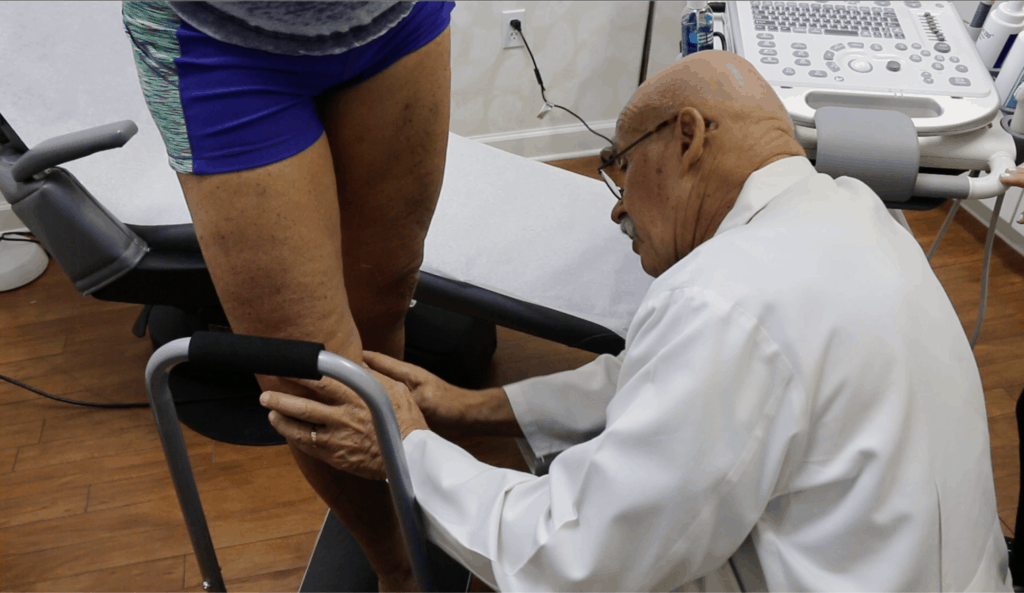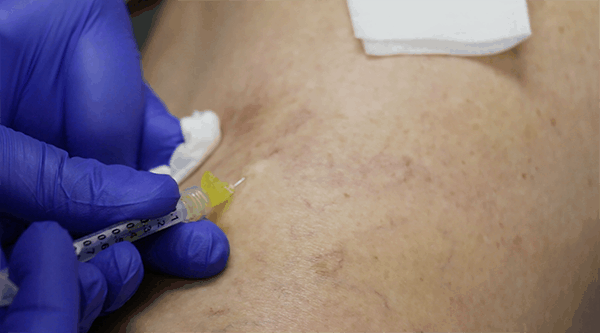One of the most common questions patients ask is, “what’s the difference between varicose and spider veins?”
You’ve probably seen spider and varicose veins on your legs, or those of someone you know. Men and women can be afflicted by these “roadmap” or “spiderweb” veins that are easily visible through the skin. Cosmetically, both types of veins can be embarrassing; but did you know they may be harmful to your health in some instances? Read on to find out how can they be treated or minimized at our office.
Click on a button below to discover the difference between spider and varicose veins.
What Are Varicose Veins?
Varicose veins are fairly common; one in four American adults, or 23% of the population, suffer from this affliction. Varicose veins are twisting, enlarged, ropy segments of vein under the skin.
While any vein can enlarge in this way, you’ll see varicose veins most often in the extremities, particularly the legs. Standing and walking increases pressure on these veins, and while most people believe them to be cosmetically unattractive, they typically do not cause any harm to the person. Sometimes, they may ache or cause discomfort. You may experience more pain after sitting or standing for long periods.
What Causes Varicose Veins?
Your tiny veins have even smaller cup-like valves that open and close to help move blood throughout the body. Varicose veins crop up when the tiny valves malfunction and the blood can pool in the vein, swelling it and causing twisting and bulging. Externally you see ropy, blue lines of veins running across your thighs and legs.
Any condition that puts excessive pressure on the legs, such as pregnancy, a sedentary lifestyle, obesity, aging, or even constipation, can cause varicose veins. You’re more likely to have this condition if your parents or another relative suffered from it.
What Are Spider Veins?
Spider veins can be found on the legs or face. They vary in size but often look like a spider’s web, which is what they are named for. Spider veins are usually red, purple, or blue and found closer to the skin’s surface. They are basically small, damaged veins that you can visually see. Cosmetically, they can be embarrassing, but like varicose veins, they typically cause no harm to the person.
 How Are Varicose Veins Different from Spider Veins?
How Are Varicose Veins Different from Spider Veins?
Medical News Today reports “Spider veins and varicose veins are different forms of a medical condition called venous insufficiency.” The primary differences between these two vein malfunctions how they manifest themselves.
Spider veins can appear on the face as well as the legs. The veins are flatter, not raised. They are most often painless. Varicose veins can cause a variety of symptoms, including bleeding, itching, and an achy feeling in the legs.
Dr. Gabor Kovacs, board certified specialist in vascular and general surgery at the Vein Care Center of Amelia Island defines the veins in this way:
“The main differences are in the size. Spider veins are tiny visible veins that are in the superficial layer of the skin. Varicose veins are larger, around 3mm and higher that bulge from under the skin.”
Because varicose veins may potentially increase the risk of other circulatory issues, it’s a good idea to have them checked by your doctor.
When Should You See a Doctor About Varicose or Spider Veins?
Spider veins are generally harmless. See your doctor if you are considering a cosmetic solution to remove them.
The same is true for varicose veins, but, because these abnormal veins can cause health issues it’s important to see your doctor if you experience:
- Discoloration of the lower leg or ankle.
- Thickening or hardening of the skin or itching skin.
- Bleeding or a skin ulcer or sore.
Your doctor can also help if you have achy, heavy legs not relieved by 15-minutes of elevation. Burning or throbbing sensations in your legs. Unexplained swelling around the ankles or lower legs.
Can You Prevent Varicose or Spider Veins?
Unfortunately, the answer is probably not, especially if they run in your family history. However, improving your circulation and muscle tone may reduce your future risk of developing varicose or spider veins. Consider:
- Increasing your exercise
- Watching your weight
- Reducing your salt intake
- Eating more fiber
- Avoiding high heels and tight hose
- Changing from sitting to standing frequently
- Elevating your legs
 How Can You Treat Spider and Varicose Veins?
How Can You Treat Spider and Varicose Veins?
Depending on their severity, you may simply choose to elevate your feet and legs to reduce discomfort. Or, if there are additional health concerns or you prefer cosmetic relief, there are several medical treatments currently available, including:
- Compression stockings or socks can improve blood flow and prevent further spider or varicose veins.
- Sclerotherapy injects an irritant directly into the affected vein. This reduces swelling and causes the vein to shrink and eventually vanish. It may take several treatments to accomplish this goal.
- Venous laser ablation is a minimally invasive treatment that uses radiofrequency or laser energy to cauterize and close the abnormal veins that cause the problem.
- Ambulatory phlebectomy is ideal for the bulging varicose veins that lie close to the skin. This outpatient procedure works by having surgeons remove the superficial veins through small, slit-like skin incisions. It’s rarely used on the smaller spider veins.
In addition to these procedures, the Vein Care Center of Amelia Island offers the revolutionary VeinGogh, a medical device that uses Microburst Technology to heat the vessels in a minimally invasive procedure with very positive outcomes. This innovative technology allows precise control to target just the broken vein without damaging the surrounding tissue.
No matter what procedure your doctor recommends, we are committed to helping you achieve physical comfort and a better appearance. If you suffer from spider or varicose veins, contact us today—we can help.
